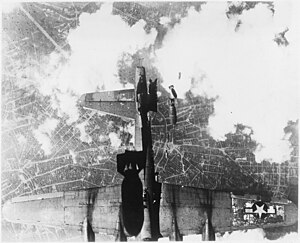In September 1943, a BBC reporter boarded a plane on an allied bombing raid over Berlin. The incredible recording he returned with forms the basis of this breathtaking experience by BBC Northern Ireland and Immersive VR Education, putting you inside a Lancaster bomber as it navigates a most dangerous journey. –BBC Media & Immersive VREducation
From Wikipedia:
The Battle of Berlin was launched by Harris in November 1943, a concerted air campaign against the German capital, although other cities continued to be attacked to prevent the Germans concentrating their defences in Berlin. Harris believed this could be the blow that would break German resistance. “It will cost us between 400 and 500 aircraft,” he said. “It will cost Germany the war.”[20] By this time he could deploy over 800 long-range bombers on any given night, equipped with new and more sophisticated navigational devices such as H2S radar. Between November 1943 and March 1944, Bomber Command made 16 massed attacks on Berlin.
A prelude to the 1943 raids came from the De Havilland Mosquito, which hit the capital on 30 January 1943, the tenth anniversary of the Nazis’ Machtergreifung. That same day, both Göring and Goebbels were known to be giving big speeches that were to be broadcast live by radio. At precisely 11.00 am, Mosquitoes of No. 105 Squadron arrived over Berlin exactly on time to disrupt Göring’s speech. Later that day, No. 139 Squadron repeated the trick for Goebbels. These were great propaganda raids which—much as the Doolittle Raid on the Japanese home islands had done for boosting American morale in April 1942—were a severe embarrassment for the German leadership. 20 April 1943 was Hitler’s 54th birthday. Bomber Command decided that they had to mark the occasion with a raid on Berlin, and it was decided that the Mosquito was the right aircraft for the job. Accordingly, No. 105 Squadron was dispatched to the German capital, successfully reaching the city with the loss of only one aircraft.[21]
The first raid of the battle occurred on 18–19 November 1943. Berlin was the main target, and was attacked by 440 Avro Lancasters aided by four Mosquitos. The city was under cloud and the damage was not severe. The second major raid was on the night of 22–23 November 1943. This was the most effective raid by the RAF on Berlin. The raid caused extensive damage to the residential areas west of the centre, Tiergarten and Charlottenburg, Schöneberg and Spandau. Because of the dry weather conditions, several firestorms ignited. The Kaiser Wilhelm Memorial Church was destroyed. Several other buildings of note were either damaged or destroyed, including the British, French, Italian and Japanese embassies, Charlottenburg Palace and Berlin Zoo, as were the Ministry of Munitions, the Waffen SS Administrative College, the barracks of the Imperial Guard at Spandau and several arms factories.[22]
On 17 December, extensive damage was done to the Berlin railway system. By this time cumulative effect of the bombing campaign had made more than a quarter of Berlin’s total living accommodation unusable.[22] There was another major raid on 28–29 January 1944, when Berlin’s western and southern districts were hit in the most concentrated attack of this period. On 15–16 February, important war industries were hit, including the large Siemensstadtarea, with the centre and south-western districts sustaining most of the damage. This was the largest raid by the RAF on Berlin. Raids continued until March 1944.[22][23][24]
These raids caused immense devastation and loss of life in Berlin. The 22 November 1943 raid killed 2,000 Berliners and rendered 175,000 homeless. The following night, 1,000 were killed and 100,000 made homeless. During December and January regular raids killed hundreds of people each night and rendered between 20,000 and 80,000 homeless each time.[25] Overall nearly 4,000 were killed, 10,000 injured and 450,000 made homeless.[26]
Despite the devastation they caused, however, these raids failed to achieve their objectives. German civilian morale did not break, the city’s defences and essential services were maintained, and war production in greater Berlin did not fall: in fact German war production continued to rise until the end of 1944. Area bombing consistently failed to meet its stated objective, which was to win the war by bombing Germany until its economy and civilian morale collapsed. The 16 raids on Berlin cost Bomber Command more than 500 aircraft, with their crews killed or captured. This was a loss rate of 5.8%, which was above the 5% threshold that was considered the maximum sustainable operational loss rate by the RAF.[27] Daniel Oakman makes the point that “Bomber Command lost 2,690 men over Berlin, and nearly 1,000 more became prisoners of war. Of Bomber Command’s total losses for the war, around seven per cent were incurred during the Berlin raids.[citation needed]
In December 1943, for example, 11 crews from No. 460 Squadron RAAF alone were lost in operations against Berlin; and in January and February, another 14 crews were killed. Having 25 aircraft destroyed meant that the fighting force of the squadron had to be replaced in three months. At these rates Bomber Command would have been wiped out before Berlin.”[28] It has been largely acknowledged that the Battle of Berlin was a failure; for the RAF,[28]British official historians have stated that “in an operational sense the Battle of Berlin was more than a failure, it was a defeat”. [29]



